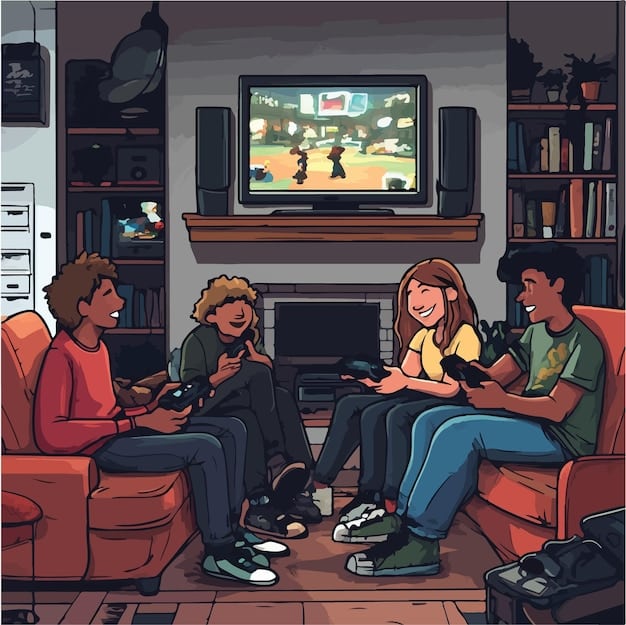Anime Dubs vs. Subs: What US Viewers Prefer & Industry Impact

Anime dubs versus subs is an ongoing debate among US anime viewers, impacting the industry by influencing accessibility, audience reach, and revenue streams for both streaming platforms and production companies.
The world of anime offers a unique viewing experience, but a key choice divides fans: anime dubs vs. subs. The debate over which is better has significant implications for the industry, particularly in the US. This article explores US viewers’ preferences and the resulting impact.
The Great Debate: Dubs vs. Subs
For anime fans in the US, the choice between watching anime with English dubs or original Japanese audio with subtitles is a personal one. However, it’s more than just a matter of preference; it reflects cultural perceptions and affects the industry in various ways.
Understanding Dubs
Dubs involve replacing the original Japanese voice acting with English voice acting. For many, this makes anime more accessible and easier to follow without needing to constantly read subtitles.
Understanding Subs
Subs refer to watching anime with the original Japanese audio and English subtitles. This allows viewers to experience the anime in its original form, preserving the nuances of the language and performance.
The preference for dubs or subs often comes down to personal taste, but it also ties into broader issues. For some, watching subs is about authenticity and cultural appreciation, while others prefer dubs for convenience and ease of viewing.

Here are some different perspectives on anime dubs vs. subs:
- Accessibility: Dubs make anime more accessible to a broader audience, especially those who may struggle with reading subtitles quickly.
- Authenticity: Subs allow viewers to experience the original Japanese voice acting, which many believe captures the true essence of the characters and story.
- Cultural Appreciation: Watching subs can be a way to engage with Japanese culture and language more directly.
- Convenience: Dubs offer a hands-free viewing experience, allowing viewers to focus solely on the visuals without needing to read.
Ultimately, the debate is about more than just preference; it’s about how anime is experienced and perceived in the US.
US Viewers’ Preferences: A Demographic Breakdown
Understanding US viewers’ preferences requires looking closer at the demographics. Different age groups, educational backgrounds, and levels of anime fandom often influence whether someone prefers dubs or subs.
Age and Generation
Younger viewers, especially those new to anime, may prefer dubs because they grew up with dubbed content. Older viewers who have been watching anime for years might lean towards subs for a more authentic experience.
Education and Language Skills
Individuals with stronger language skills or those who have studied Japanese might prefer subs. They can appreciate the nuances of the original language and are less reliant on translations.
Level of Fandom
Hardcore anime fans often prefer subs, viewing them as the “purest” form of anime. Casual viewers might opt for dubs to enjoy anime without focusing on reading subtitles.
Different demographics have different preferences, and these preferences shape how content providers cater to their audiences. Streaming services often offer both dubbed and subbed versions to accommodate diverse tastes.

Here are the main factors influencing viewer preference:
- Accessibility for New Viewers: Dubs often serve as an entry point for those new to anime, making it easier to engage with the content.
- Nostalgia: Some older fans have fond memories of watching dubbed anime on television and continue to prefer dubs out of habit.
- Cultural Immersion: Many fans who prefer subs feel they are getting a more authentic cultural experience and enjoy learning Japanese phrases.
- Voice Acting Quality: Both Japanese and English voice acting have their strengths, and some viewers simply prefer one over the other.
Understanding these demographic nuances helps content creators target their offerings more effectively, ensuring that they cater to both dub and sub fans.
Impact on the Anime Industry: Production and Distribution
The dubs vs. subs preference has a significant impact on how anime is produced and distributed in the US. Both dubbing and subbing require investments that affect the profitability and availability of anime.
Dubbing Costs
Dubbing involves hiring voice actors, translators, and audio engineers, which can be expensive. High-quality dubs can increase production costs but also attract a broader audience.
Subbing Costs
Subbing requires translation and typesetting, which is generally less expensive than dubbing. However, accurate and well-timed subtitles are crucial for maintaining viewer engagement.
Distribution Strategies
Streaming services like Crunchyroll, Netflix, and Funimation offer both dubbed and subbed versions of anime. This strategy aims to cater to different viewer preferences and maximize viewership.
The financial impact of dubs and subs is substantial. Dubbed anime can generate more revenue by reaching a larger audience. Subbed anime, while less costly to produce, caters to a dedicated fanbase willing to pay for an authentic viewing experience.
Economic effects on production and distribution include these key points:
- Increased Production Value: Investing in high-quality dubs can increase the perceived value of an anime series.
- Market Expansion: Offering both dubs and subs allows anime to reach different market segments and expand its audience base.
- Revenue Streams: Dubs can drive revenue through wider viewership, while subs can generate income from dedicated fans.
- Licensing Agreements: Dubbing and subbing rights are often negotiated separately, affecting licensing agreements between Japanese and US companies.
The Role of Streaming Platforms
Streaming platforms play a crucial role in the distribution of anime. By offering both dubs and subs, they can cater to diverse preferences and optimize viewership. This strategic approach impacts the industry by influencing which anime series are licensed and produced for international audiences.
The Rise of Simulcasts: Bridging the Gap
Simulcasts, which involve streaming new anime episodes shortly after they air in Japan, have become increasingly popular. This trend has influenced the dubs vs. subs debate by prioritizing subbed versions initially.
Initial Prioritization of Subs
Simulcasts typically release subbed versions first because they require less production time. Fans eager to watch the latest episodes are willing to accept subs in exchange for immediate access.
Delayed Dub Releases
Dubbed versions often follow weeks or months later due to the time needed for translation and voice acting. This delay can influence viewers to try subs while waiting for dubs.
Simulcasts have created a unique viewing pattern where subs are the initial offering, and dubs are a later addition. This model has several implications.
The impact of simulcasts is apparent across various areas:
- Increased Sub Viewership: Simulcasts have increased the overall viewership of subbed anime by providing immediate access to new episodes.
- Reduced Piracy: Simulcasts offer a legal way to watch anime quickly, reducing the incentive for piracy.
- Fan Engagement: The immediate availability of episodes encourages fan discussions and community building.
- Market Trends: Simulcasts have helped shape market trends by setting expectations for the release and availability of new anime.
The Influence of Digital Distribution
Digital distribution has revolutionized the anime industry, making it easier to simulcast content and reach global audiences. This has also influenced the business models of production companies and streaming platforms, creating new opportunities for growth and innovation.
Fan Culture and Community: The Social Aspect
The dubs vs. subs debate also has a significant social dimension. Anime fans often form communities around their preferred viewing method, leading to discussions, debates, and shared experiences.
Online Communities
Online forums, social media groups, and fan conventions provide platforms for fans to discuss their preferences. These discussions often become passionate, with strong opinions on both sides.
Cosplay and Fan Art
Cosplay and fan art are ways for fans to express their love for anime. Whether they prefer dubs or subs, these creative outlets help build a sense of community and shared identity.
Fan culture plays a critical role in shaping perceptions and influencing industry trends. The dubs vs. subs debate is not just about personal preference; it’s also about belonging to a community and sharing a passion for anime.
Here are ways that fans integrate dubs and subs into their experience:
- Community Building: Fans bond over shared preferences, creating communities dedicated to either dubs or subs.
- Shared Experiences: Watching anime together, whether dubbed or subbed, creates shared experiences and memories.
- Cultural Exchange: The dubs vs. subs debate encourages discussions about cultural differences and translation nuances.
- Artistic Expression: Fan art and cosplay often reflect the fan’s preferred viewing method, adding another layer to their creative expression.
The Culture of Appreciation
The rise of anime fandom has led to a culture of appreciation. Whether through dubs or subs, fans celebrate the artistry and storytelling of anime. This appreciation is what ultimately drives the industry forward, creating new opportunities for creators and viewers alike.
Future Trends: Convergence and Inclusivity
Looking ahead, the anime industry is likely to see a convergence of dubbing and subbing practices. Technology and evolving viewer expectations will drive greater inclusivity and customization.
AI and Dubbing Technology
Advancements in AI and machine learning could lead to more efficient and high-quality dubbing. AI-powered tools can automate translation and voice synchronization, reducing costs and production time.
Customizable Viewing Options
Streaming platforms may offer more customizable viewing options, allowing viewers to adjust subtitle settings, voice options, and even translation styles. This would create a more personalized viewing experience.
The future of the dubs vs. subs debate is likely to be less about choosing one over the other and more about creating flexible and inclusive viewing options. Technology will play a key role.
What will this evolution mean for the industry?
- Enhanced Accessibility: AI-driven dubbing and customizable viewing options will enhance accessibility for a global audience.
- Cost Efficiency: Technology will reduce the costs associated with dubbing and subbing, making anime more affordable to produce and distribute.
- Personalized Experiences: Viewers will have more control over their viewing experience, tailoring it to their preferences.
- Global Integration: The anime industry will become more globally integrated, with seamless distribution and localization across different markets.
A Borderless World
In the future, the idea of choosing between dubs and subs might become less relevant. Instead, viewers will have the freedom to experience anime in whatever way resonates most with them. This borderless approach will foster a greater appreciation for anime as a global art form.
| Key Point | Brief Description |
|---|---|
| 🗣️ Dubs | English voice-overs make anime accessible to a wider audience in the US. |
| 🇯🇵 Subs | Original Japanese audio with subtitles offers an authentic experience. |
| 📺 Simulcasts | Prioritize subs initially, bridging the gap until dubs are available. |
| 🤖 AI Dubbing | Future trends include AI-driven dubbing for efficiency and personalized viewing options. |
Frequently Asked Questions
Anime dubs replace the original Japanese audio with English, while subs provide English subtitles over the original Japanese audio. The choice often depends on personal preference.
Many viewers prefer dubs because they make anime more accessible, especially for those who don’t want to focus on reading subtitles. It allows for a more relaxed viewing experience.
Subs are preferred by those seeking an authentic experience, valuing the original Japanese voice acting and cultural nuances. They often feel it better captures the emotion.
Simulcasts typically release subbed versions first to provide immediate access to new episodes. Dubbed versions often follow weeks or months later, creating a staggered release.
The future likely involves AI-enhanced dubbing and customizable viewing options. This could merge dubbing and subbing into a more personalized experience.
Conclusion
The debate between anime dubs and subs highlights the diverse preferences within the US anime community. From accessibility to authenticity, different factors influence viewers’ choices, impacting production and distribution trends in the industry. As technology advances, the future promises more personalized and inclusive viewing experiences for all anime fans.





